Mujeres Excluidas y Equidad de Género
DOI:
https://doi.org/10.70833/rseisa13item190Keywords:
Inequality, Vulnerability, Gender equity, Social PsychologyAbstract
This study started from the problem of the forms of inequality and vulnerability that women experience and that generates social exclusion due to the absence of gender equality. It was carried out in the city of Encarnación, Itapúa, Paraguay, during the months of March to August (2019). The study sought to describe the relationship between inequality and gender equity with respect to Social Psychology. Methodologically, it had a DITRIAC design as a cross-sectional mixed investigation. The concurrent modality was chosen because in this modality the collection and analysis of quantitative and qualitative data are constructed at the same time. A closed survey was applied, from a probabilistic sampling with a type of stratified random sampling, it had as a sample members of governmental and non-governmental institutions (Secretariat of Indigenous and Peasant Affairs of the Government of Itapúa, Municipality of Encarnación, CODEMU , Ministry of Public Defense, Division of Attention to Victims of Family Violence of the National Police and JCI) of the city of Encarnación, who are in charge of people who go through a situation of vulnerability such as ethnic origin, sexual orientation, unemployment, domestic violence, lack of own home, disability, conducting a survey.The most outstanding results have shown that it is necessary for gender equality to be valued and promoted not only by public authorities, through interventions and investments (policies and other measures), but also at the individual and community level. Said gender equity must be recognized as a human right and engine of development, through the work of Social Psychology.
Downloads
References
Estivill, J. (2003). Panorama de la lucha contra la exclusión social. Conceptos y estrategias. Ginebra: OIT. Obtenido de https://books.google.com.py/books?id=EMARv3lXR3wC&pg=PP5&source=kp_read_button&redir_
esc=y#v=onepage&q&f=false.
González, M., Moragas, M., & Posa, R. (2017).La igualdad de género en el Estado paraguayo: Los peligros ante las oleadas anti-derechos.Coordinación de Mujeres del Paraguay (CMP), 632-642. Obtenido de http://www.cde.org.py/wp-content/uploads/2017/12/CODEHUPY-TEMA-del-a%C3%B1o-Estado-Laico.pdf.
Hernández Sampieri, R., Fernández, C., & Baptista, P.(2014).Metodología de la Investigación. Ciudad de México: McGrawHill. Obtenido de http://observatorio.epacartagena.gov.co/wp-content/uploads/2017/08/metodologia-de-la-investigacion-sexta-edicion.compressed.pdf.
Lamas, M. (1996). La perspectiva de género.Grupo de Información en Reproducción Elegida (GIRE), 1-15. Obtenido de http://www.inesge.mx/pdf/articulos/perspectiva_genero.pdf.
Marín, G. (1980). Hacia una psicología social comunitaria. Revista Latinoamericana de Psicologia, 171-180. Obtenido de https://www.redalyc.org/pdf/805/80512114.pdf.
Martínez, E. (2001). Las Políticas Sociales en el Desarrollo Local. Obtenido de http://www.ubiobio.cl/cps/ponencia/doc/p8.3.htm.
MERCOSUR. (2014). Directrices de la Política de Igualdad de Género del MERCOSUR. Asunción: MERCOSUR. Obtenido de http://www.sice.oas.org/trade/mrcsrs/decisions/dec1314_s.pdf.
Ministerio de la Mujer. (2018). IV PlaNI – PLAN NACIONAL DE IGUALDAD: Allanar obstáculos para la igualdad Sustantiva. Asunción.
Org. Women Watch. (2013). Panorama general de los logros alcanzados y problemas encontrados en la
promoción.Asunción: Org.Women Watch. Obtenido de https://www.un.org/womenwatch/daw/Review/responses/PARAGUAY-Spanish.pdf-
REDUCA. (2015). Situación educacional en Paraguay: una mirada desde los principales indicadores
Educativos .UNIÓN EUROPEA.
RMAAM. (2014). Política de Igualdad de Género del MERCOSUR. Montevideo: MIDES. Obtenido de http://www.inmujeres.gub.uy/innovaportal/file/34842/1/directrices_12nov2014.pdf.
Rojas, E., & Santillán, M. (2015). La mortalidad infantil en el Mercosur desde una perspectiva de derechos humanos. CONICET .
Scott, J. (1986). El género: una categoría útil para el análisis histórico. Obtenido de http://www.bivipas.unal.edu.co/bitstream/10720/646/1/261-Scott,%20Joan%20W.pdf.
Serafini, V., & Imas, V. (2015). Igualdad de Género y Principales Brechas en Paraguay.Asunción: ONU Mujeres. Obtenido de http://www.ciudadmujer.gov.py/application/files/5114/9693/8060/Igualdad_de_Genero_y_principales_brechas_en_Paraguay.pdf.
UNESCO. (2012). Igualdad de Género. UNESCO, 104-115. Obtenido de https://es.unesco.org/creativity/sites/creativity/files/digital-library/cdis/Iguldad%20de%20genero.pdf.
Downloads
Published
How to Cite
License

This work is licensed under a Creative Commons Attribution 4.0 International License.
Creative Commons Attribution License CC-BY
You are free to:
Share — copy and redistribute the material in any medium or format.
Adapt — remix, transform, and build upon the material for any purpose, including commercially.
Under the following terms:
Attribution — You must give appropriate credit, provide a link to the license, and indicate if any changes have been made. You may do so in any reasonable way, but not in any way that suggests that you or your use is endorsed by the Licensor.







